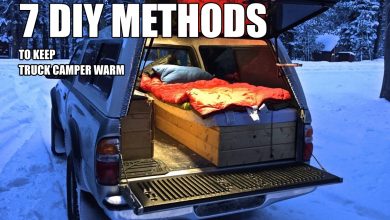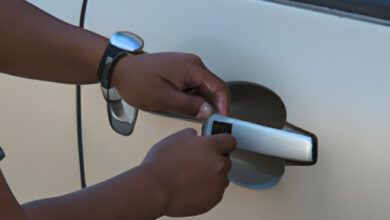Mastering the Art of Jump Starting your Ford F650 like a Pro!

Jump-starting a vehicle can seem like a daunting task, especially when it comes to larger trucks like the Ford F650. However, with the right knowledge and steps, it can be a straightforward process. In this article, we will provide you a comprehensive step-by-step guide about how to Jump Start Ford F650? This blog post will equip you with all the necessary information to successfully jump-start your Ford F650.
How to jump start ford F650? To jump-start a Ford F650, locate the battery under the hood, attach the positive (red) jumper cable to the positive terminal and the negative (black) cable to a metal ground point, then start the functioning vehicle and let it run for a few minutes before attempting to start the F650.
How To Jump Start Ford F650?
If you find yourself in a situation where you need to jump start your Ford F650, it is important to follow the proper steps to ensure a successful and safe outcome. First, it is crucial to understand the Ford F650 battery and its specifications, as this will affect the method used for jump starting.
Before attempting to jump start the vehicle, it is necessary to take safety precautions, such as wearing protective gear and ensuring the area around the battery is clear of any obstructions.
Additionally, it is important to carefully inspect the battery for any signs of damage or corrosion before proceeding. When it comes to actually jump starting the Ford F650, it is vital to follow a step-by-step process, which may involve connecting the positive and negative cables to the corresponding terminals on both vehicles.
It is also essential to allow the vehicle to run for a while after jump starting in order to ensure that the battery has fully charged.
Step by Step Guide to Jump Start Ford F650
Jump starting a Ford F650 is a simple process that can be done in a few easy steps. By following these guidelines, you can safely and effectively jump start your Ford F650:
First, park the donor vehicle close to the Ford F650 and turn off the engine. Then, open both hoods and locate the battery terminals on each vehicle.
Next, connect the red positive jumper cable to the positive terminal of the Ford F650’s battery, and then connect the other end to the positive terminal of the donor vehicle’s battery.
After that, connect the black negative jumper cable to the negative terminal of the donor vehicle’s battery, and then connect the other end to an unpainted metal surface on the Ford F650, away from the battery.
Once the cables are securely connected, start the donor vehicle and let it run for a few minutes to charge the Ford F650’s battery.
Finally, try starting the Ford F650. If it doesn’t start, gently rev the donor vehicle’s engine to give the Ford F650’s battery an extra boost. Once the Ford F650 is revived, remove the jumper cables in the reverse order that they were connected.
Using a Jump Starter Pack
If you find yourself needing to jump start a Ford F650, using a portable jump starter pack is a convenient solution. To begin, make sure the jump starter pack is fully charged and turned off.
Then, locate the vehicle’s battery and attach the red clamp to the positive terminal and the black clamp to a metal, unpainted part of the vehicle’s frame.
Once the clamps are securely in place, turn on the jump starter pack and then attempt to start the vehicle. If the engine starts, let it run for a few minutes to ensure the battery is properly recharged. Always remember to follow the manufacturer’s instructions for the specific jump starter pack being used to ensure a safe and successful jump start for your Ford F650.
Alternative Methods to Jump Start Ford F650
Sometime jumper cables or a jump starter pack does not help to jump start your Ford F650, there are alternative methods you can explore to get your vehicle running again.
One option is to use a portable power bank or portable jump starter specifically designed for large vehicles like the Ford F650. These devices can provide the necessary boost to jump start your truck without the need for another vehicle.
Another alternative method is to use a manual hand-crank jump starter. This old-fashioned method involves using a hand-crank device to generate power and jump start the vehicle.
Additionally, if you have access to a second vehicle, you can try using a push start method. This involves manually pushing the vehicle to gain some momentum and then quickly releasing the clutch to engage the engine.
However, it’s important to note that these alternative methods should be used with caution and may not always be as effective as traditional jumper cables or a jump starter pack. It’s always best to have the proper equipment on hand, but in a pinch, these alternative methods may help get your truck back on the road.
Testing the Battery and Charging System
Testing the battery and charging system of your vehicle is critical, especially after jump-starting. To verify the battery’s condition, use a multimeter to measure its voltage.
A healthy battery should typically have 12.6 to 12.8 volts. If the reading is less, it may indicate that your battery is undercharged, whereas a higher reading can imply overcharging affecting the battery’s lifespan.
After doing this, start the vehicle and retest the voltage. A functioning charging system should yield a reading of roughly 13.8-14.4 volts, indicating the alternator effectively charges the battery. If the reading is more or less than these values, it might be a sign of a malfunctioning charging system.
This procedure helps determine whether your jump start was sufficient or if there are underlying issues with your vehicle’s battery or charging system.
Common Mistakes to Avoid when jump starting Ford F650
Jump starting a Ford F650 is a simple enough process, but there are several common mistakes to point out that people often make.
First, not connecting the jumper cables correctly can lead to extensive damage to your vehicle’s electrical system. Always remember to connect positive (red) clamp to the positive terminal of your flat battery and the working battery, then negative (black) clamp to the working battery’s negative terminal and to the grounded metal part of the flat battery’s car.
Secondly, starting your Ford F650 immediately after connecting the cables can cause a surge in power that could potentially damage your car’s electrical systems. Allow it to charge for a few minutes first.
Lastly, leaving the vehicle running while attempting to jump start it could lead to complications, it’s safer to turn off both vehicles. Avoiding these errors can ensure a successful and safe jump start.
Maintenance Tips to Prevent Battery Issues
For optimum vehicle performance, it is pivotal to offer proactive measures to maintain the Ford F650’s battery and prevent future jump starts. Regular inspection should be a priority to identify and immediately address issues.
Simple signs of battery issues such as slow engine crank, illuminated warning lights, and swollen battery case are red flags that should not be overlooked. The battery terminals should be kept clean and checked for corrosion, which can prevent the car from starting.
Additionally, extended periods of inactivity can cause a battery to degrade, so it’s recommended to use or run the vehicle regularly. If your battery is more than three years old, it is advisable to have its performance evaluated annually.
Temperatures also play a significant role in battery life, so ensure vehicle storage in a garage during extreme weather conditions. Understanding basic maintenance is imperative to prevent battery issues and ensure a reliable ride.
Conclusion
We hope our complete guide on how to jump start a Ford F650 has been helpful to you. Jump starting a vehicle can sometimes be a challenging task, especially with larger trucks like the Ford F650.
However, by following our step-by-step instructions, you’ll be able to confidently jump start your truck and get back on the road in no time. Remember to always prioritize safety and consult your vehicle’s manual for specific instructions. If you have any further questions or need additional assistance, please don’t hesitate to reach out to us at howtruck.com. Safe travels!




